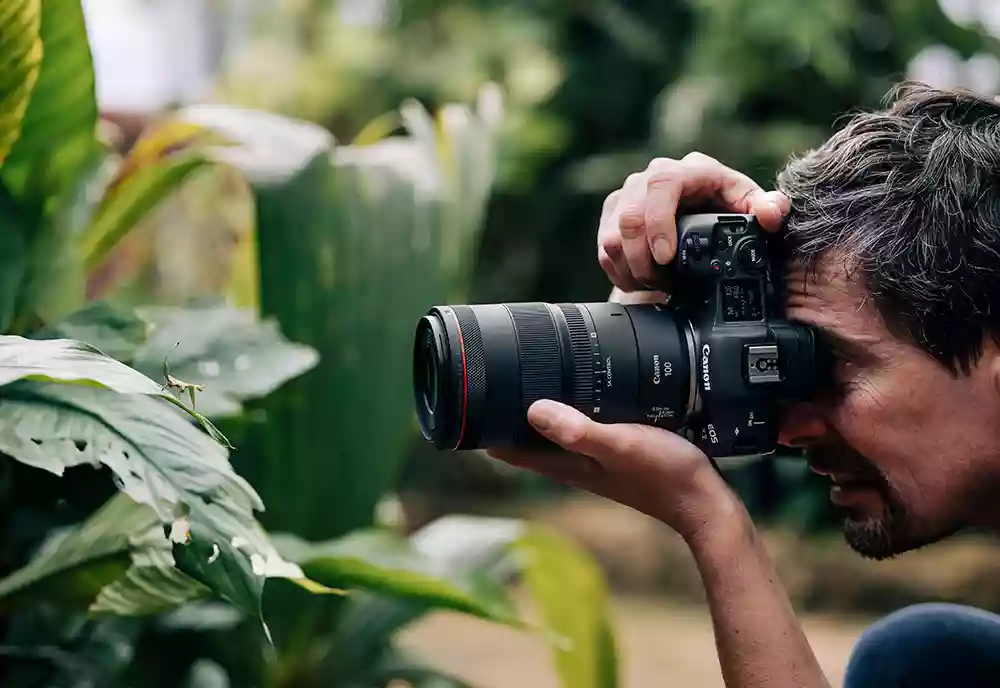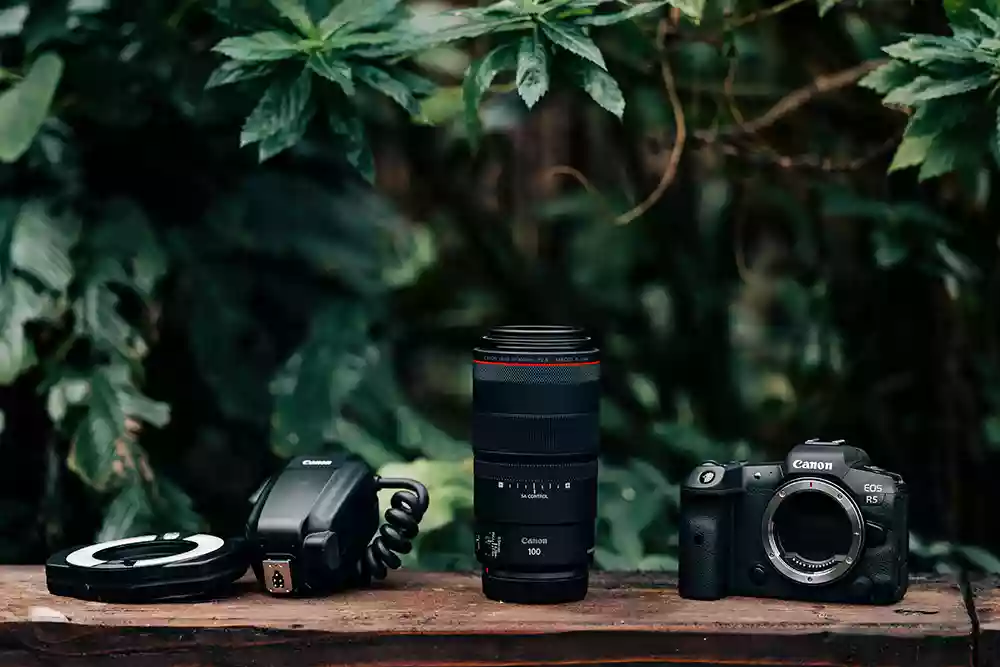- Call us: 01444 237070
- Contact Us
- Stores
- Sign In / Register
-
- Back
- Used Cameras
- Used Accessories
- Used Lenses
- Used Video
- Used Film Equipment
- Used Stock Alert
- Used Blank Test
- Sell or Part Exchange
- Used Clearance
- Recently Added Used Equipment
- Park Picks
- All Used Black Friday Deals
- Faulty
- Trade-In
- Blog
- New in
- Call us
- Contact us
- Stores
- Sign in
- Categories
- Tips & Inspiration
- Reviews
- News
- Events
- Features
- Buying Guides
- Competitions
Canon RF 100mm f2.8L Macro Lens Review
In this blog post we review the Canon RF 100mm f/2.8L Macro IS USM Lens, the first true macro option for RF-mount, complete with plenty of image samples and our own first look video review.

If you shoot with or are considering the Canon mirrorless camera system there are of course the existing wide angle RF 35mm f/1.8 Macro IS STM and the telephoto RF 85mm F2 Macro IS STM lenses which have 1:2 macro abilities. Reviews throughout the web are extremely positive about both of these and rightly so, as results are sharp with very decent close-up capabilities. I use a 1:2 macro lens myself and it is extremely rewarding and fun to use, despite the lack of a ‘true’ macro magnification ratio of 1:1. But Canon has other ideas to capitalise on the short flange back distance which their mirrorless design offers and have released an innovative new optic with some ground breaking technology.

Sample 1 Mounted on EOS R5. Exposure: 1/160. f/4.5 ISO 3200 (no flash)
Enter the world’s first 1.4x magnification macro lens (for interchangeable lens cameras) which includes a number of innovative features to provide users with a versatile stills and video lens with suitably pin sharp results. No other lens provides a greater than 1:1 macro magnification ratio at the time of launch, without using a separate extension tube. This is big news and Canon has compared the new RF lens with the 100mm EF macro version to demonstrate just how good this new full frame option is. Just about everyone who owns the EF version loves the results it delivers and Canon are certain the new mirrorless version will be just as well received.

Sample 1 - 100% crop just look at those details of the eye!
Comparison between RF and EF 100mm Macro lenses
Let’s take a look at the optical design before we dive in, as this gives us some clues as to how Canon has changed the design from the EF version.
|
|
||
|
Close Focus at 1:1 |
0.28m (0.26m at 1.4x) |
0.3m |
|
Working Distance at 1:1 |
112mm |
133mm |
|
Working Distance at 1.4x |
86mm |
NA |
|
Maximum Reproduction Ratio |
1.4x |
1:1 |
|
Number of elements/groups |
17/13 |
15/12 |

We can see that as far as the optical design for macro work goes, the newer RF mount holds all the cards. It can focus closer, capture images at a higher magnification and the shorter distance between the sensor and lens provides a closer working distance. So if you are after nitty gritty, detailed, up-close and in your face macro images, the mirrorless lens is clearly for the win and you won’t need an extension tube either.

Sample 2 Mounted on EOS R5. Exposure: 1/320. f/4 ISO 6400 (no flash)
Regarding image quality, sharpness and a resolution comparison between these two, Canon have stipulated that the RF version captures quality at least as good as the EF version, with or without an extension tube attached. So if we consider the RF 100mm is a world first 1.4x magnification there’s a lot to celebrate as no image quality has been sacrificed. Thanks Canon, you rock!

Sample 2 - 100% crop, testament to the high ISO capabilities of the R5 as well as this lens.
New SA control ring bokeh feature
Let’s look at the enticing new SA control ring feature which the RF 100mm f/2.8L Macro IS USM arrives with. What is it and how does it work?
Canon has long been focused on delivering beautiful bokeh for photographers and videographers, to separate their subject from the background in the most appealing way possible. After all they already offer a unique mirrorless DS lens in the form of the RF 85mm f/1.2L USM DS with defocus capabilities. With the new RF 100mm macro they’ve gone a step further to provide users with a truly distinctive bokeh altering feature, in the form of a lens ring which can adjust the appearance of spherical aberrations. This is made possible technically as there are two focus motors in the lens (Nano USM). One motor controls regular focus and one controls the floating elements which are responsible for spherical aberration. The effects are appealing, allowing the user to choose between hard round bokeh balls and smoother out of focus rendering. I’ll go into more detail below but this SA control ring also lets you adjust general out of focus smoothing effects anywhere from your subject to the foreground or background. That might sound a bit whacky but in practice it’s a lot of fun and facilitates creative options on the fly, which typically would have required a filter, maybe a tilt shift or some clever post production techniques previously.

Playing with the new SA control ring to adjust bokeh balls in a creative portrait
The ring itself turns on the lens barrel and is lockable to prevent any accidental shifts. When the ring is turned anti-clockwise past the focal point, bokeh outlines become softer while when turned in front of the focal point bokeh becomes harder. When left at the focus point bokeh is once again softer. If you turn the ring clockwise the exact opposite happens. These effects work for macro, portraits, products, video, essentially any subject at all. The aperture is also made up of 9 blades, which lends itself to smooth round bokeh in the first instance, even before we adjust the resulting bokeh with the SA ring. Let’s just say this lens is a bokeh lover’s bonanza and loads of fun to use.
Image stabilisation comparison
Optical stabilisation has been around for years and proves to be extremely useful in real world situations, particularly on telephoto lenses where small movements become exaggerated, effectively ruining our images with blur. With macro work even the most minute movements are even more obvious and create a challenge for designers and end users. Photographers and videographers can capitalise on Canon’s mirrorless full frame system which has IBIS in it’s core as shown in this comparison table.
|
|
||
|
Optical stabilisation |
5-stops |
4-stops |
|
Stabilisation at 1:1 |
2-stops |
2-stops |
|
Maximum stabilisation |
8-stops combined with IBIS |
4-stops |

Sample 3 Mounted on EOS R5. Exposure: 1/320. f/3.5 ISO 1600 (no flash)
The mirrorless lens wins overall once again, particularly when combined with in-body camera stabilisation found on bodies such as the outstanding EOS R5. Canon also told us that higher stops of compensation can be achieved when combined with the hybrid IBIS system, depending on user technique. Essentially if you are hand holding for macro work, shoot fast and be rock steady so that the camera/lens combination can perform at their optimum helping to minimise any shake they pick up.

Sample 3 - 100% crop of snake
Focus breathing for video
With the rapid rise of content creation - AKA video, manufacturers are having to consider focus breathing when they develop new optics. Whilst this is not always a concern, with a lens that offers extreme close-ups as well as telephoto opportunities it is clever of Canon to make this a priority. If you shoot movies or close-up photography, you definitely don’t want obvious focus breathing, or subject magnification fluctuation as it is also known. This can smother focus pulls and make it all be impossible to stitch together stacked images, which is a technique often required for extremely detailed macro work.
With this in mind Canon exceeded the capabilities of the EF lens version, which displays an already decent 2mm movement from the focal plane at 1.0x magnification. The new RF lens halves this to just 1mm under similar conditions, for considerably less obvious fluctuation in magnification. Another win for the mirrorless RF system, in part thanks to a closer lens distance to the sensor.

Image quality
After all is said and done with new features, higher magnification and excellent stabilisation we still crave to create beautiful, sharp and compelling images and videos to help tell our story. As briefly mentioned earlier Canon has disclosed that the RF 100mm f/2.8L Macro IS USM is optically brilliant in this department too, certainly comparable to the accomplished EF version.
With a design incorporating 17 optical elements together with Canon’s proprietary Super Spectra coating colours are natural, lens flare and ghosting are well controlled and the lens is extremely sharp where you want it to be on the focal plane. Whilst the aperture does close to f/32 this will cause diffraction so typically we’d stay around f/8 - f/11 where the lens performs at its best. Unless of course you are shooting for a narrow focal plane in which case the large f/2.8 aperture does result in beautifully rendered images and bokeh.

Sample 4 Mounted on EOS R5. Exposure: 1/200. f/4.5 ISO 6400 (no flash)
The extra optics make for a slightly heavier weight at 730g compared to 625g for the EF-mount. Thankfully the RF 100mm f/2.8L Macro feels extremely comfortable in the hand with excellent balance on full frame bodies. Whist we’re on the subject of ergonomics the lens also sports a Control Ring to change settings while still viewing the subject as is common on RF lenses.
Build quality is high with the same dust and moisture resistance typically found on professional quality L-Series lenses. If the camera body is weather sealed (which it inevitably will be) photographers can continue working in poor conditions through rain, wind, dust and snow, which is essential for a lens of this type.
Accessories

Accessories including the Canon Macrolite Macro Ring Lite MR-14EX II
Macro work often requires extra lighting and any quality lens can also be protected with a lens protector or UV filter. With a 67mm filter thread as the EF version, filters are affordable and practical. We would recommend a higher quality filter to complement the optics and there a number of choices listed below. Typically we wouldn’t want to slow this lens down too much so a solid ND might not be the right filter.
67mm Filters to fit the RF 100mm Macro lens
- Canon 67mm Protect Filter - stop accidental damage to the front element without shifting colour or contrast
- PolarPro Quartzline 67mm UV Filter - A step up from a protector, this high quality UV filter offers perfect colour neutrality for content creators of all types
- Hoya 67mm Ultra Pro Circular Polariser - cut down reflections and glare from foliage and close-up subjects
- H&Y Revoring 67-82mm Variable Neutral Density ND3-ND1000 And CPL Filter - whilst it is a bit of a mouthful this filter concept is outstanding with variable ND for video and stills as well as CPL functionality for a range of thread sizes, all in one!
Watch our video - Canon RF 100mm f/2.8L IS USM Macro Lens First Look
Conclusion
I think it’s safe to say that a lot of photographers (and videographers) will be rejoicing at the release of this macro lens for the full-frame EOS R system. With a newer lens mount there will inevitably be gaps in more specialist lenses to begin with and true macro was one of those gaps, which is now amply filled with a more than capable option. Anyone who loves bokeh, enjoys making extreme close-ups, portraits or generally finds photography fun will see some sort of appeal in this lens. If you are lucky enough to be considering it then don’t hesitate to pull the trigger as you will not find an alternative as compelling as this on the market.
All about RF Mount Lenses
Our blog is packed with camera equipment reviews including several deep dives into RF mount lenses including the new super telephoto duo released at the same time as this macro lens. Why not take a gander at some of the posts we have:
- Large Aperture Super Telephoto RF Duo
- Canon RF 70-200mm f/4L IS USM and RF 50mm f/1.8 STM Lenses Compared
- Three Super Telephoto RF lenses reviewed (RF 600mm f/11, RF 800mm f/11 and RF 100-500mm tele)
- Canon RF 70-200mm f/2.8L IS USM lens review
- First look at the Canon RF 24-240mm f4-6.3 Lens
Share this post:
By Nick Dautlich on 14/04/2021
Nick Dautlich
Senior Content Writer and Product Reviewer
Nick Dautlich is the Senior Content Writer and Product Reviewer at Park Cameras, with over 15 years of photography experience. A Sony Imaging Professional and expert reviewer, Nick has worked with major brands such as Canon, Sony and Nikon. His work is also featured on Vanguard World UK’s website, Capture Landscapes, and Shutter Evolve. Nick’s photography includes National Trust projects and magazine covers and he is passionate about landscapes and storytelling. Nick also enjoys hiking and teaching his children about nature. Learn more on his profile page.

Trade in your old equipment
Fast and easy trade in service ensures your old gear is collected efficiently and you are paid quickly! It's very simple to trade in your unwanted photography gear. Just head over to our dedicated Sell or Part Exchange page, fill out the details, and we'll get back to you with an offer for your old gear. Take the cash, or put it towards the cost of your new gear. It's up to you! Find out more
sign up to the newsletter
Keep up to date on the latest photography news, events and offers. Sign up now
